Here’s a list of best affiliate link disclosure examples and ideas for bloggers to implement the best way to disclose your relationship with the affiliate products that you promote.
After you implement any of these styles, you’ll not have to worry about non-compliance with affiliate terms and conditions imposed by AdSense and many high-paying affiliate partners such as Bluehost, Impact Radius, and more.
This article may get a bit too technical, if you aren’t familiar with speeding up WordPress and optimization, you can get CloudInnovare to get this job done.
Also, if you offer consultation services, you’ll need an appointment scheduling tool such as Trinitio or Calendly. I prefer Trinitio over Calendly as it offers more value for money in comparison.
So, let’s dive into the article right away.
What’s an affiliate link disclosure?
If you are reading this article, I am going to assume that you are already aware of what an affiliate link is.
In simple terms, affiliate links are unique links with a unique string attached at the end. This URL contains tracking information that you get from your affiliate partners.
When someone clicks on the affiliate link and completes a cash transaction, your affiliate partner takes note of this and pays you the promised commission.
But, why do you need an affiliate link disclosure?
Well, FTC(Federal Trade Commission) has made it illegal to not disclose your relationship with a company if you are promoting their products.
This step was taken to stop internet fraud and help an average shopper by revealing if the posted review or promotional article is unbiased or not.
What will happen if you don’t disclose affiliate links?
You may get heavily fined by the FTC. On top of that, most high-paying affiliate companies today are from the US.
This means that they are also required by law to implement this from their end.
So, if you don’t insert affiliate link disclosure, they might suspend your account.
I get regular updates from companies and affiliate portals regarding their policies updates and disclosure requirements.
Carefully going through these newsletter emails and make sure that all my niche portals and blogs follow all the guidelines recommended by them.
After all, there’s no harm in inserting an affiliate link disclosure.
Does an affiliate link disclosure reduce the affiliate income?
No, affiliate link disclosure will not reduce your affiliate revenue.
It may help in building more credibility with your followers online.
In my honest opinion, if my favorite blogger is honestly disclosing their relationship with a particular product, it directly means that they believe in that product and are willing to vouch for it publicly.
So, it will encourage me and others to purchase the product even more. This will eventually increase the revenue of your entire affiliate campaign.
Disclose your affiliate links whenever needed.
Inline affiliate link disclosure for bloggers vs popup affiliate disclosures
For many underlying problems, I don’t recommend using popup affiliate disclosure or a link to a separate affiliate disclosure page.
Why?
It’s a hassle and most people will not click on an affiliate disclosure popup link. People visit your website to learn, read and explore a particular topic.
You must disclosure your affiliate relationships without them having to go through an entire process of visiting a different privacy policy page.
It’s mildly annoying and may also turn them away and ruin their impression of your website.
If you ask me, it also seems a bit sneaky that you are not disclosing the information on the same page.
Affiliate link disclosure examples: How do you incorporate them in your blog posts?
If you are using WordPress, it is a fairly simple process.
You just need to install a plugin and click a few buttons, and within a few minutes, you will have an ethical way of disclosing your affiliate relationship with your readers.
I use a WordPress plugin called Ad Inserter.
If you don’t want to use any WordPress plugin and have some experience dealing with WordPress codes, you can directly insert your affiliate link disclosure into your ‘single.php’ file.
Make sure that you are not inserting or modifying the code of a live WordPress website.
The best place to insert your affiliate link disclosure
You may have seen many websites disclosing affiliate relationships in many places on their websites. I believe that’s a bit too much.
That said, you have to and must insert a disclosure whenever and wherever you post an affiliate link on your website.
As a blogger, the most common page where you promote your affiliate products is the single posts.
The blog post page is what the visitors care about as it is the only post that drives them from Google to your website.
So, make sure to include an affiliate link disclosure at the top of your article.
Some bloggers manually insert affiliate link disclosures on posts in which they promote some products.
But, this can get a bit tedious. So, as a rule of thumb, you should just insert a disclosure by default.
Adding it via WordPress template file for a single post will automatically show this disclosure on every single blog post.
Now that you are aware of all the major and minor details, we can jump right into the list.
12 Best affiliate link disclosure examples
Affiliate Link Disclosure Examples: Create and Go

Create and Go is one of the most popular blogs about blogging that’s run by Alex and Lauren.
They share some actionable info about affiliate marketing, product promotions, making money selling courses, and much more.
If you take a look at the screenshot taken from one of their blog posts, you’ll see that they have ethically disclosed that they have inserted one or multiple affiliate links in their blog posts.
What made me list them as the top recommendation here is their affiliate disclaimer itself.
They have written a custom, non-generic and quirky affiliate disclosure which makes it readable and genuine.
Take some inspiration from their disclosure and try crafting something like that for your own blog.
Affiliate Link Disclosure Examples:1stwebdesigner
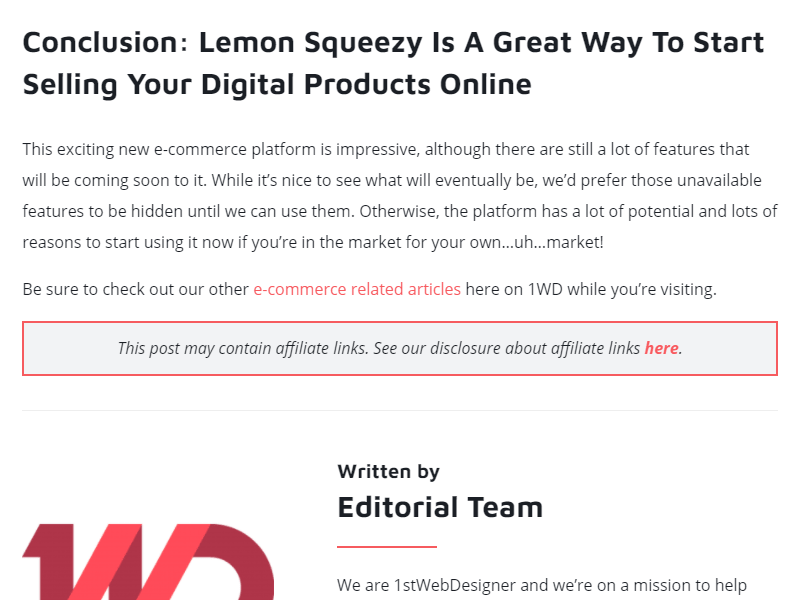
Moving a bit away from the blogging industry, web design blogs share some golden nuggets when it comes to design news, tutorials, and web development guides.
Plus, most digital service providers such as web hosting companies, template sellers offer high commissions.
So, it makes sense for web design and graphic design blogs to share and promote such products, and make good money with affiliate marketing.
1stwebdesigner is one of the most reputable and longest-running web design blogs out there.
They post tremendous articles and help millions of readers and web design, enthusiasts and promote many products.
Instead of inserting an affiliate disclosure at the top of the article, they post it at the bottom just before that “Author’s Box”.
OneHourProfessor

OneHourProfessor is another great blog tutor. This blog helps you build, promote and make money with your blog posts.
But, Ron (the guy behind this website) also shares everyday topic-related blog posts. This makes this website a very lucrative point of sales for many different affiliate products.
Although he doesn’t highlight or put the affiliate disclosure in a colored box, you can still clearly see the affiliate disclosure right below the featured image of that blog post.
The affiliate disclaimer is a pretty simple and straightforward, one-liner that makes it clear that he’s using affiliate links in the said blog post.
Brilliantaffiliate

Justine’s blog, BrilliantAffiliate is dedicated to affiliate marketing and it helps people from all over the world to choose the best affiliate marketing programs to yield the most income from their traffic.
Her disclaimer is even more impressive and unique.
She doesn’t post a one-line affiliate notice. Instead, she has a complete paragraph at the end of her articles stating how she uses affiliate marketing to make money from the website.
What’s more interesting is the fact that she also discloses the various methods using which she makes money.
If you have a loyal fanbase and followers, you can easily incorporate such an affiliate disclosure making their income sources public and transparent.
Take a look at the disclosure and see if you can take away a few things.
BlogTyrant
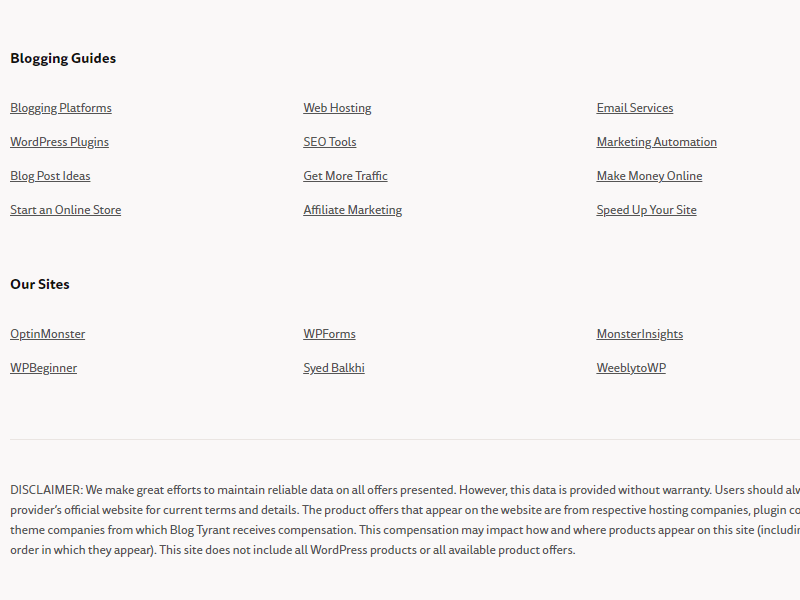
Want to launch your own blog that generates some revenue? BlogTyrant might be the blog guru you are looking for.
Their articles, reviews, and tutorials are read by hundreds of thousands of readers from all over the world.
And, they generate most of their revenue from product promotion and affiliate marketing.
They have chosen to display their disclaimer at the bottom of the footer on all the pages including the homepage and other static pages.
As mentioned earlier, if you don’t want to go through the tedious process of manually inserting disclaimers on blog posts, you can choose this route and get the job done.
The caveat here is most visitors will never get to read it as it is not displayed alongside the main content of the blog post.
CodeinWP
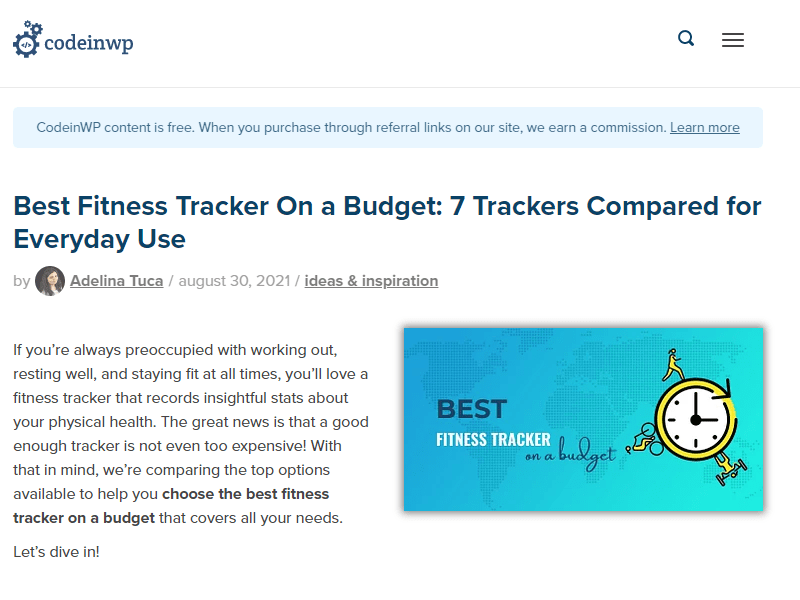
I am a huge WordPress enthusiast. I code, modify and speed WordPress websites on a daily basis. So, obviously, I read a lot of WordPress blogs on a daily basis.
One such blog is CideinWP.
This blog gets a lot of visitors from the web design and development community.
So, you can expect them to promote a lot of web design and WordPress-related products such as WordPress hosting, WordPress themes, and plugins, etc.
CodeinWP discloses its affiliate links right at the top of every article.
I really appreciate it when popular blogs and publications offer such transparency.
Affiliate Link Disclosure Examples:WPKube
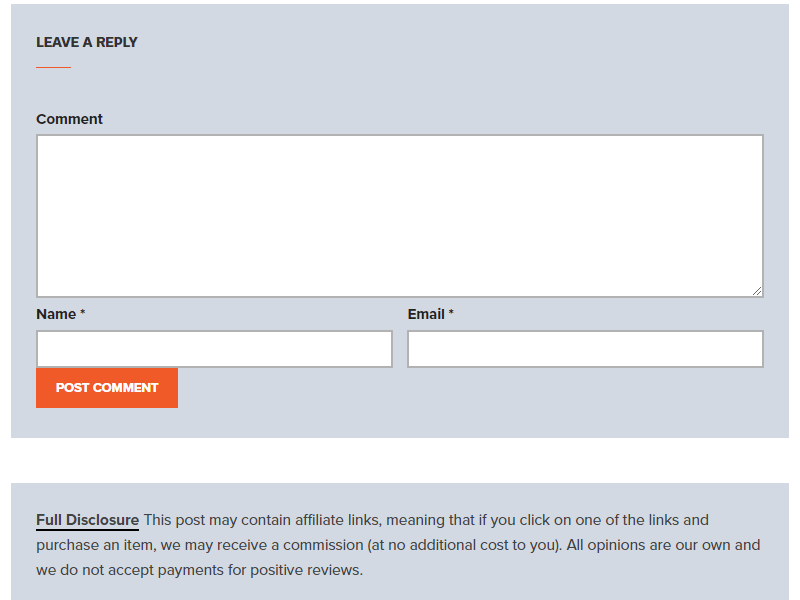
WPKube is one of the most popular web design blogs out there. WPKube is updated by a number of talented writers including WordPress developers, web design, and more.
Just like any other popular WordPress blog, WPKube also promotes a bunch of reputable web design-related affiliate products which includes web hosting and design tools.
The affiliate disclosure is displayed below the comment form of their blog posts. So, a user will have to scroll to the bottom of the blog post to read the disclaimer.
FirstSiteGuide
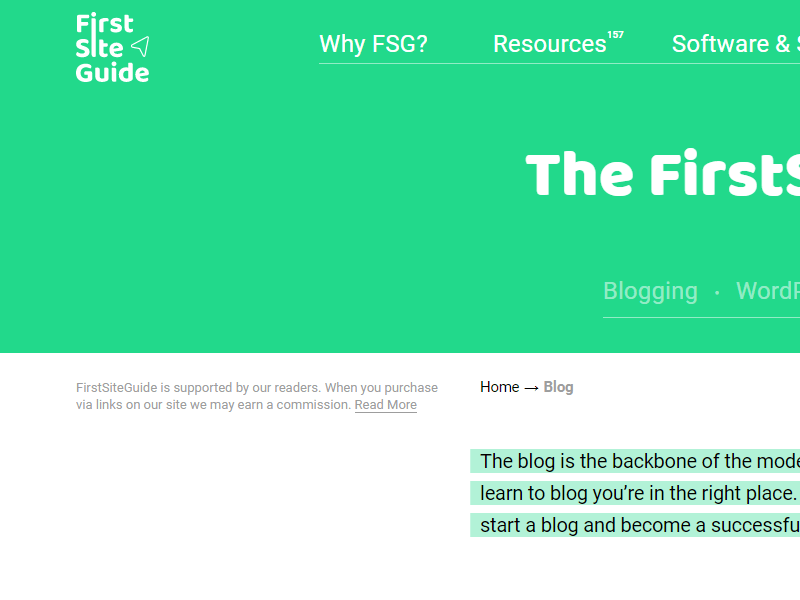
We all need those tutorials to help us start a new blog, try new software, and write the first blog post.
For all such needs, FirstSiteGuide is the best free resource portal that posts high-quality marketing, content marketing, and blogging tutorials.
They promote a lot of software, tools, and web hosting companies in the blogging tutorials.
To comply with FTC regulations, they disclosure their affiliate links at the beginning of the article where everybody can read it.
Plus, they also have a ‘Read more’ link that you can click to explore more about their revenue generation policies.
Affiliate Link Disclosure Examples:Ryan Robinson (RyRob)
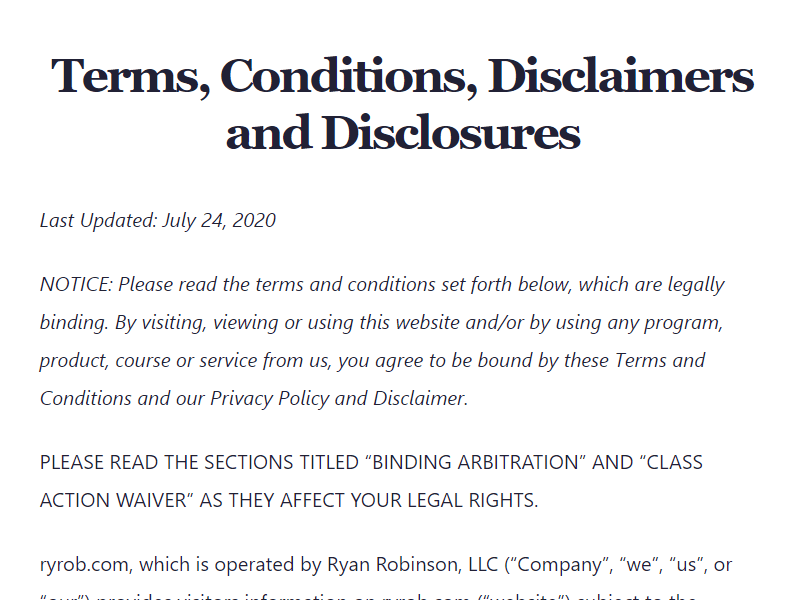
Ryan is a famous blogger who’s been killing it in the blogging scene.
He promotes affiliate products such as web hosting companies, blogging products, marketing tools, and more.
Ryan has a dedicated page with all the information about affiliate income, sources, and how he uses affiliate links in his blog posts.
Affiliate Link Disclosure Examples:Making Sense of Cents

If you ask me to name one personal finance blog that inspires almost all aspiring bloggers, it would be Making Sense of Cents.
Run by Michelle, Making Sense of Cents is a powerhouse.
From cleverly managing one’s personal finance to investing and making passive income, Making Sense of Cents shares a lot of informative articles that are read by millions of visitors monthly.
Michelle always inserts the affiliate disclosure at the top of her blog posts. That too in CAPITALIZED BOLD LETTERS.
This shows that she is extremely confident and is 100% sure that the products she’s recommending will only benefit the readers.
Affiliate Link Disclosure Examples: Website Setup
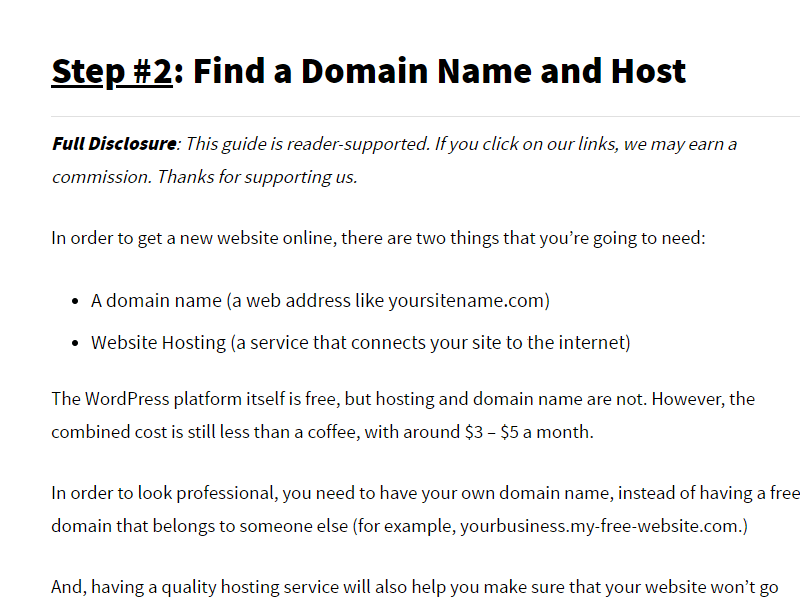
Website Setup is another tutorials blog that teaches people how to start a blog, website, e-commerce store, and educational portal.
All the tutorials are offered for free. So, they have to generate revenue using affiliate products.
I reckon a large chunk of their revenue comes from promoting web hosting companies such as Bluehost.
They have a clear and readable affiliate disclosure at the top of your article.
Also, they have included a link that you can click to learn more about their affiliate policies.
Affiliate Link Disclosure Examples: Design Bombs

DesignBombs is a web design blog where I get my weekly dose of design news, product reviews, typography recommendations, and more.
They have been generating revenue for a long time by promoting affiliate products such as WordPress themes, plugins, and web hosting companies.
Instead of disclosing their affiliate links on the posts page, they have a dedicated web page where they list all the disclaimer information.
Conclusion: Best Affiliate Link Disclosure Examples
In this article, I shared with you some of the best affiliate link disclosure examples to help you design your own affiliate link disclosure.
Which one did you like the most and how are you going to use this article to improve your blog? Share with us your thoughts in the comment section below.
Also, if you want us to add some more items to this list, please drop them in the comment section below as well.